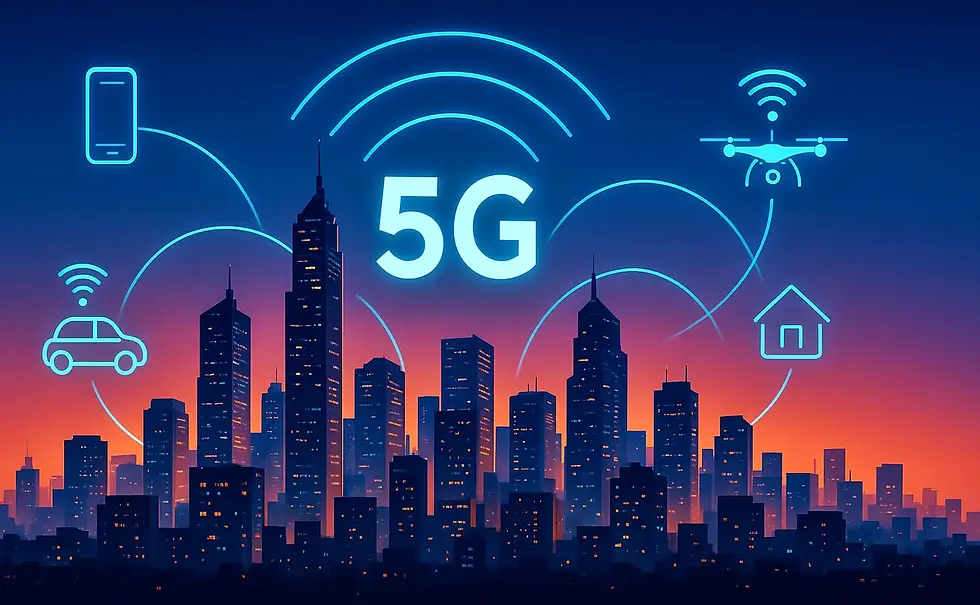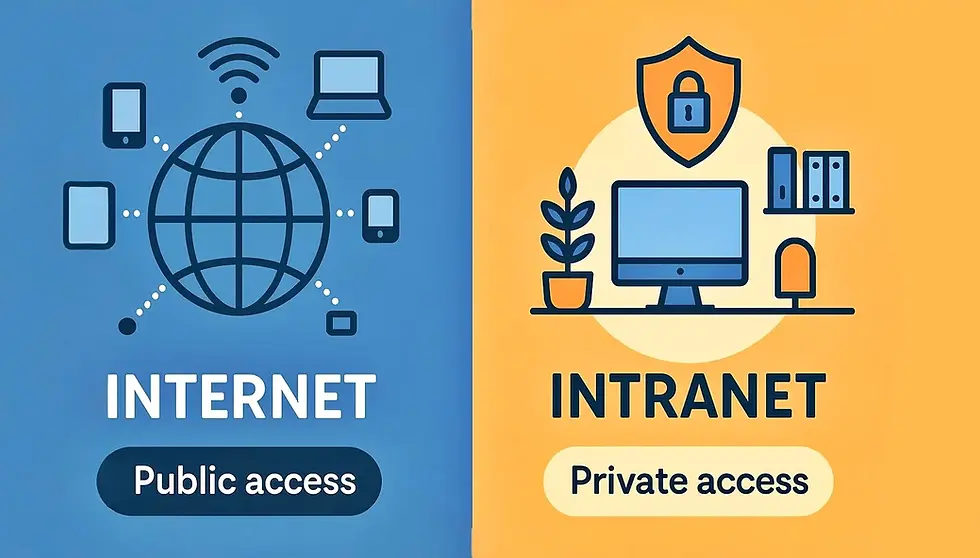5G Network: The Next Frontier in Communication and Connectivity
- Kalyan Bhattacharjee

- May 26, 2023
- 3 min read
Updated: 2 days ago

Introduction: 5G - A Reality, Not Just a Promise
5G is no longer a distant vision it’s here and transforming how we live. With over 2.25 billion connections worldwide as of 2024, adoption is growing four times faster than 4G, ushering in a communication revolution that's reshaping industries and societies.
Beyond faster downloads, 5G enables technologies that simply weren’t possible before like real-time automation, immersive AR experiences, and next-gen smart infrastructure. Its impact is quickly becoming foundational to the digital world.
How Fast & Vast Is 5G Becoming?
Average download speeds now hover around 200 Mbps globally, with urban areas seeing speeds up to 1 Gbps or more.
Latency has dropped into single-digit milliseconds, enabling near-instant interactions—faster than the blink of an eye (~250 ms).
5G supports 1 million+ devices per square mile, making it ideal for dense IoT environments.
The Triad of 5G: What It Actually Powers
3 core capabilities define 5G’s potential - eMBB (Enhanced Mobile Broadband), URLLC (Ultra-Reliable Low Latency Communications), and mMTC (Massive Machine-Type Communications).
Together, they support everything from smooth 8K streaming to smart city sensors sending precise data streams.
Use Cases That Make 5G Network Real & Relevant
5G is already powering real-world applications, from ultra-fast mobile streaming to low-latency IoT devices and smart city infrastructure.
Smart Logistics at Sea
A private 5G multi-hop network has been set up at Latvia’s Freeport of Riga to improve connectivity. Ships communicate with each other and the port over 100 miles offshore, making maritime logistics both efficient and autonomous.
Robotaxis That Respond in Real Time
5G enables dynamic network slicing, prioritizing mission-critical traffic for robotaxis smoothing congestion, improving safety, and lowering costs for fleet operators. This real-time responsiveness allows autonomous vehicles to adapt instantly to changing road conditions, making transportation more reliable and efficient.
Smart Public Infrastructure
Vodafone UK's rollout of 5G Standalone (SA) networks could save up to £580 million annually by optimizing energy use in schools and hospitals even enabling predictive diagnostics.
Private 5G for Industrial Efficiency
India’s inaugural private 5G network is now operational at Numaligarh Refinery, Assam. It supports real-time IoT, AR/VR, and digital twins highlighting domestic innovation under the Atmanirbhar Bharat initiative.
Modern 5G Evolution: More Than Just Faster Internet
Fixed Wireless Access (FWA): Providers now offer speed-based 5G plans comparable to fiber - gaining traction where traditional wired infrastructure lags. 5G FWA may account for 35% of new broadband connections, projected to serve 350 million users by 2030.
Robot Integration & Digital Twins: A new framework using Network Digital Twins (NDTs) enables real-time monitoring of 5G performance for mobile robots, improving both autonomy and reliability in industrial environments.
Why It Matters: Real-World Impact
“Whether it’s autonomous vehicles, immersive medicine, or smart manufacturing - 5G is the invisible force powering our connected future.”
TL;DR: What Makes 5G a Game-Changer
5G delivers ultra-fast speeds, low latency, and massive device connectivity unlocking new possibilities in automation, mobility, and real-time digital experiences.
Feature | Why It Matters |
Faster Speeds (200 Mbps+) | Ideal for video streaming, edge AI, and more |
Ultra-Low Latency | Perfect for robotaxis, remote surgery, real-time apps |
Massive Device Support | Enables smart cities, IoT applications |
Real Use Cases | Ports, smart infrastructure, private 5G, etc. |

Key Takeaways
5G is more than a technological upgrade - it’s a catalyst for innovation, efficiency, and global connectivity. By combining lightning-fast speeds, ultra-low latency, and the ability to support millions of connected devices, 5G is enabling breakthroughs across industries from smart cities and autonomous transportation to immersive healthcare and industrial automation.
The real power of 5G lies in its capacity to bridge the digital and physical worlds, making autonomous systems, real-time analytics, and predictive technologies not just feasible, but practical at scale.
People Also Ask – FAQ on 5G Networks 📌
What makes 5G different from 4G?
Ans: 5G offers much faster speeds, lower latency, and the ability to connect more devices simultaneously compared to 4G networks.
How fast is 5G compared to current networks?
Ans: 5G can deliver speeds up to 10 Gbps, which is around 100x faster than 4G LTE, enabling ultra-HD streaming, VR, and real-time applications.
Will 5G replace Wi-Fi?
Ans: No. While 5G provides high-speed connectivity, Wi-Fi will still be used in homes, offices, and public spaces for cost-effective local networking.
Is 5G safe for health?
Ans: Yes. 5G technology follows strict international safety standards, and studies show no evidence of harmful radiation beyond regulated limits.
How will 5G impact future technologies?
Ans: 5G will power innovations like autonomous vehicles, smart cities, advanced IoT devices, and immersive experiences in AR/VR.
Related Keywords: 5G network, 5G technology, future of communication, 5G connectivity, 5G applications, smart cities 5G, IoT and 5G, 5G future, 5G revolution, 5g network near me, 5g network in india, 5g network speed, 5g network coverage, how to check 5g network in my area, 5g network launch date in india, 5g network check, fintech shield







Comments